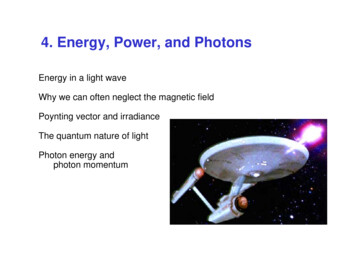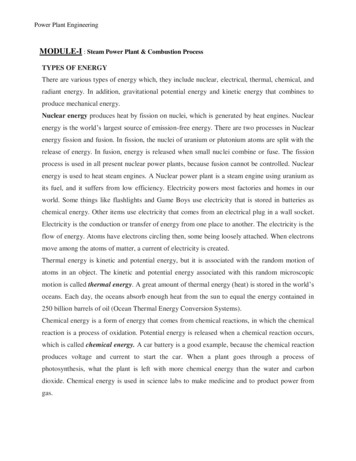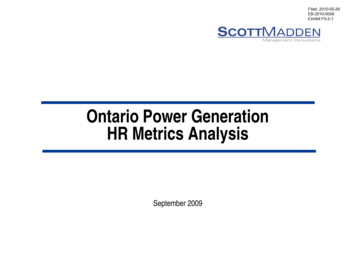
Transcription
4. Energy, Power, and PhotonsEnergy in a light waveWhy we can often neglect the magnetic fieldPoynting vector and irradianceThe quantum nature of lightPhoton energy andphoton momentum
An electromagnetic wave in empty spaceThe electric and magnetic fields are in phase.The electric field, the magnetic field, and the k-vector areall perpendicular: E B kAnd the magnitude of the B field is simply related to themagnitude of the E field: B0 E0 c0where the speed of the wave is given by:c0 1 0 0 3 108 m/s
Why we often ignore the magnetic fieldIn many cases, we ignore the effects of the magnetic field componenton charges. How can we justify this?Felectrical FmagneticThe force on a charge, q, is: F qE q v Bso:Since B E/c:FmagneticFelectricalFmagneticFelectrical where v is thevelocity of thechargeqvB qEv cSo, as long as a charge’s velocity is much less than the speed of light,we can neglect the light’s magnetic force compared to its electric force.
The Energy density of a light wave1UE E2211 2The energy density of a magnetic field is: U B B2 The energy density of an electric field is:Units check:In empty space: 0 8.854 10-12 C2/Nm2Electric field: units of V/mC2 V 2 U E 2 2Nm mUsing: C Nm/V U E Nm Joule energy 33mmvolume
The Energy density of a light wave (cont.)Using B E/c, andc we have:UB 1 , which together imply thatB E 11 21 2E E UE 2 2So the electrical and magnetic energy densities in light are equal. Theelectric and magnetic fields each carry half of the total energy of the wave.Total energy density:U UE UB E2We can never ignore the magnetic field’s contributionto the total energy of a light wave.
The Poynting vectorThe power per unit area in a beam isgiven by the Poynting vector:c tS c2 E x BAJustification (but not a proof):Energy passing through area A in time t: U V U A c tVolume V A c tSo the energy per unit time per unit area: U V / ( A t ) U c c E2 c2 E B And the direction E B k is reasonable.John Henry Poynting(1852-1914)
The Irradiance (often called the Intensity) S (r , t )A light wave’s average powerper unit area is called its“irradiance” or “intensity”.T1 Tt T / 2 S (r , t ') dt 't T / 2Let’s compute the irradiance of a light wave, likethe ones we’ve been discussing so far. E E0 cos k r t B B0 cos k r t real amplitudesSubstituting these into the expression for the Poynting vector, 2S c E B, yields: 22S (r , t ) c E0 B0 cos (k r t )
The Irradiance (continued) 22S (r , t ) c E0 B0 cos (k r t )The irradiance (or intensity) is the magnitude ofthe time average of the Poynting vector: I (r , t ) S (r , t )TSince the time-dependence of S is given by a cos2,we must take the time average of this function.The average of cos2(x) is ½: 1 2I r , t c E0 B0 2
The Irradiance (continued)Since the electric and magnetic fields are perpendicular and B0 E0 / c,I 12 c E0 B02becomes: I 12 c E20where 2222E0 E0 x E0 y E0 z Note: this formula still holds even if we had used complex amplitudes E0 except in that case: 222E0 E0 x E0 y E0 z 2
Units of irradiance I 12 c E20We’ve already seen that E2 has units of Joules/m3.[I] m J 3s mWattsm2Irradiance is power per unit area.
Irradiance: examplesThe irradiance of sunlight, atthe top of the atmosphere:I 1360 W/m2The irradiance of the Tridentlaser (Los Alamos National Lab):I 2,000,000,000,000,000,000,000,000 W/m2
The photoelectric effectIt was observed* that unusual things happen whenwe shine light on a piece of metal in a vacuum:1. The light can cause electrons to beejected from the metal surface (that’snot so unusual)2. The energy of these electrons (i.e.,their velocity once they leave themetal) does not depend on the lightintensity, although the total number ofelectrons does depend on intensity(rather unusual).3. If the light frequency is loweredbelow a certain value (which dependson the type of metal used), then NOelectrons are observed (very veryunusual!)* Hertz (1887), Lenard (1890’s)
A few “dark clouds”In 1900, the prevailing view was that all theimportant problems in physics were solved."The more important fundamental laws and facts ofphysical science have all been discovered, and theseare now so firmly established that the possibility of theirever being supplanted in consequence of newdiscoveries is exceedingly remote. Our futurediscoveries must be looked for in the sixth place ofdecimals." - Albert A. Michelson, 1894"There is nothing new to be discovered inphysics now. All that remains is more andmore precise measurement" - Lord Kelvin,1900In 1900, Kelvin described two “dark clouds” that were notyet explained using the classical theories of Newton (forparticles) and Maxwell (for electromagnetic waves). Hewas fully confident that they soon would be explained.Robert Millikan (1868-1953)William Thomson, 1st Baron Kelvin(1824-1907)One such unexplained effect (although not one of the onesthat Kelvin had in mind) was the photoelectric effect. It cannotbe explained using a wave theory of light. In 1905, Einsteinoffered an explanation which required light to be a particle, nota wave. This explained all of the observations, and wasconfirmed by experiments in 1915 by Robert Millikan.
Light is not only a wave, but also a particle.Photographs taken in dimmer light look grainier.Very very dim(about 3000 photons)Getting brighterVery dimDimBrightVery bright(over 30,000,000 photons)When we detect very weak light, we find that it is made up of particles.We call them photons.
PhotonsThe energy of a single photon is: h or (h/2 ) where h is Planck's constant: 6.626 x 10-34 Joule-sec.One photon of visible light contains about 10-19 Joules (not much!) is the "photon flux," orthe number of photons persecond in a beam. P / h where P is the beam power(in watts).
What is the energy in a light wave?Is there a contradiction? Earlier we found that theenergy density of an electromagnetic wave is:U wave U E U B E 2which does NOT depend on the frequency of the wave.But now we’re saying that each photon has energy h , whichmeans that the total energy density of an EM wave is:Uparticle N·h where N is the number of photons per m3. This explicitly doesdepends on the frequency of the wave.These two formulations always give the same answer: Uparticle UwaveThus, the number of photons (per unit volume) must be proportional to E2,and the proportionality constant must depend on the frequency of the wave.
Counting photons tells us a lot abouta light source.Random (incoherent) light sources,such as stars and light bulbs, emitphotons with random arrival timesand a Bose-Einstein distribution.Laser (coherent) light sources, onthe other hand, have a moreuniform (but still random)distribution: Poisson.
Photons have momentumIf an atom emits a photon, it "recoils" in the opposite direction.If the atoms are excited and then emit light, the atomic beam spreadsmuch more than if the atoms are not excited and do not emit.
Photon momentum: the Compton effectPhotons have no mass and always travel at the speed of light, so wecan’t use p mV to determine their momentum.Instead, the momentum of a single photon is: h/ , or k since k 2 Compton scattering: the photontransfers some of its energy to aparticle (causing the particle toaccelerate).This causes a change in the photon’senergy, and therefore in its wavelength(since E h hc/ ).Compton’s discovery of this effect(1923) was an important proof of theparticle nature of light.Arthur H. Compton(1892 – 1962)
Photons—radiation pressureSince photons carry momentum, they can therefore exert pressure.This is known as radiation pressure.Note that energy per unit volume is the same as pressure(which is force per unit area):1 J m3 1 N m m3 1 N m 2Radiation pressure is usually very small.A few situations when radiation pressure cannot beneglected: Comet tails (other forces are small) Spacecraft trajectories (small force over a long time) Stellar interiors (resists collapse due to gravity) Really big lasers (1015 Watts or more!) Optical trapping of tiny objects by a focused laser:
Photon momentum - current researchFrom Physical Review Letters*, December 2008:There are two different proposals for the momentum of light in atransparent dielectric Despite many tests and debates overnearly a century, momentum of light in a transparent dielectricremains controversial.The two proposals:The experiment (2008):When light exits out of an opticalfiber, the momentum transferred tothe fiber is:(a) in the direction of the lightpropagation (1908)(b) in the opposite direction (1909)momentum?light* W.She et al., Phys. Rev. Lett., 101, 243601 (2008)
Photons"What is known of [photons] comes from observing theresults of their being created or annihilated."Eugene HechtWhat is known of nearly everything comes from observing theresults of photons being created or annihilated.
a light source. Random (incoherent) light sources, such as stars and light bulbs, emit photons with random arrival times and a Bose-Einstein distribution. Laser (coherent) light sources, on the other hand, have










